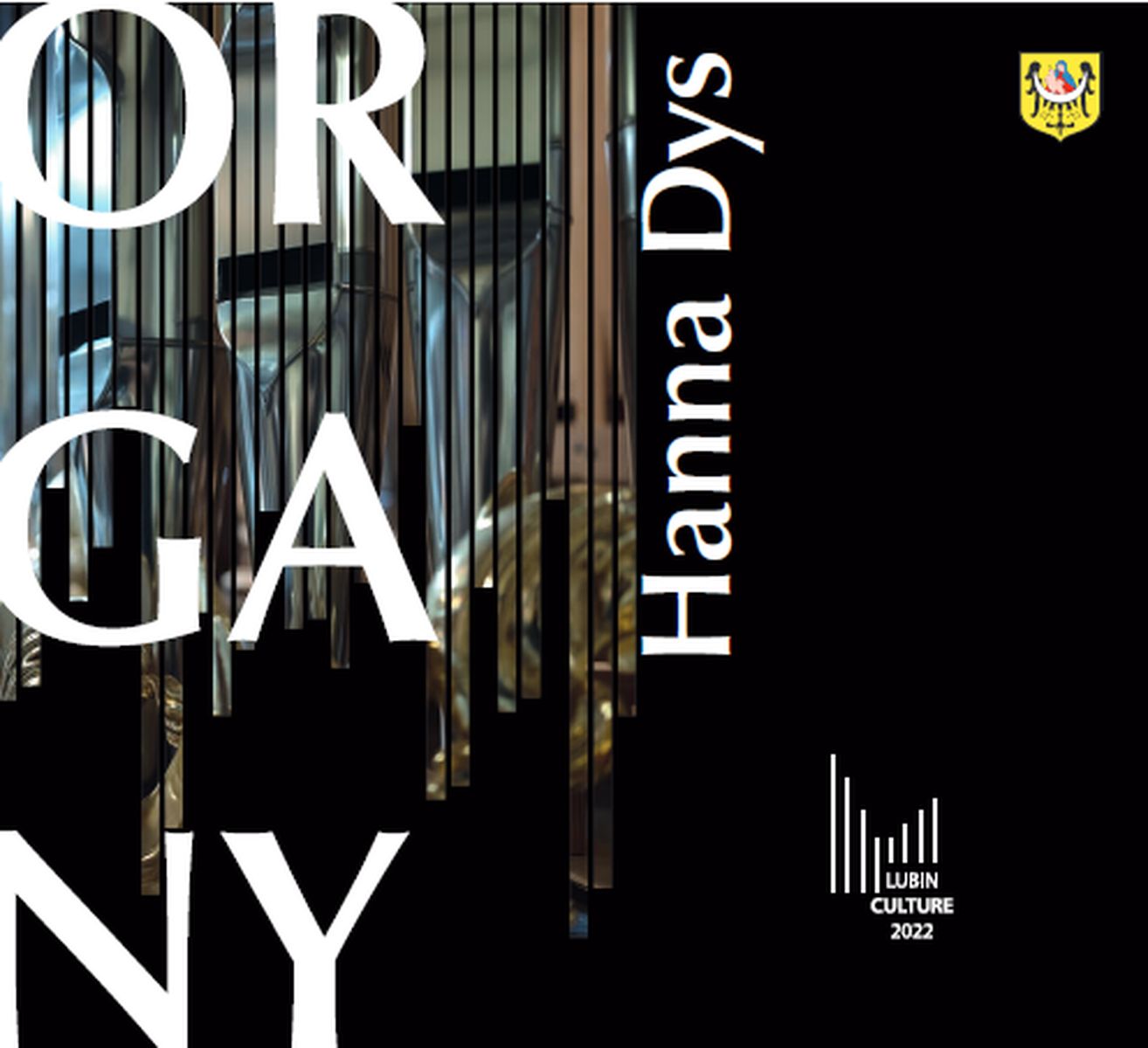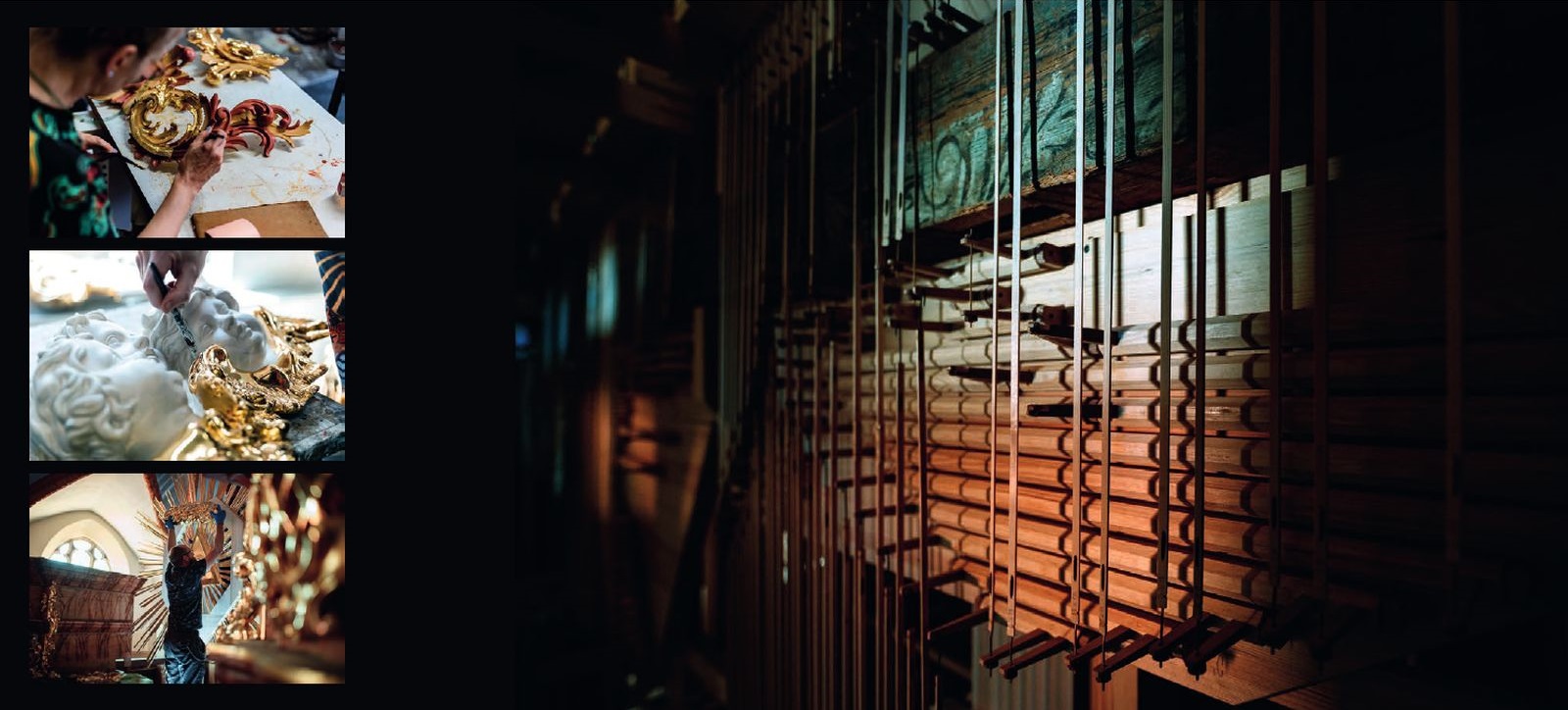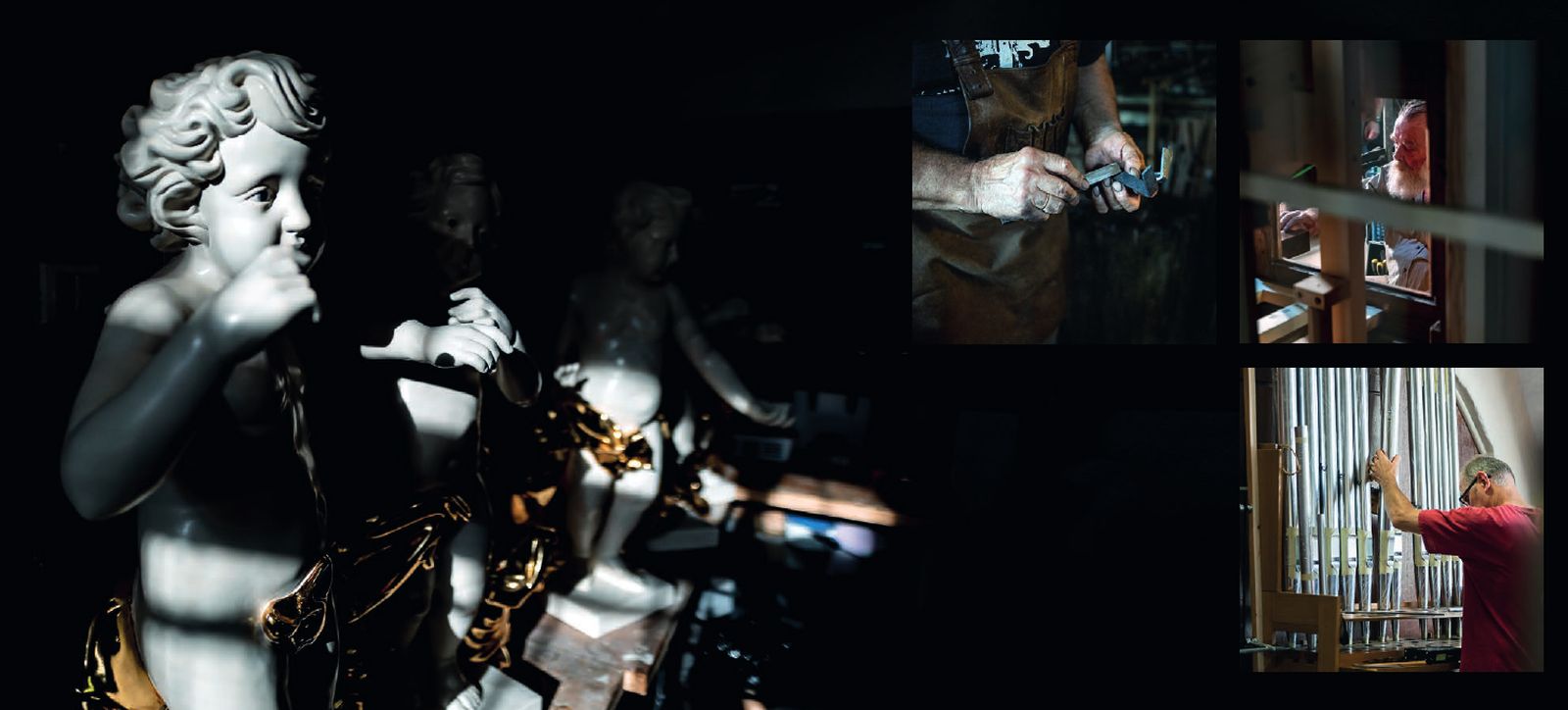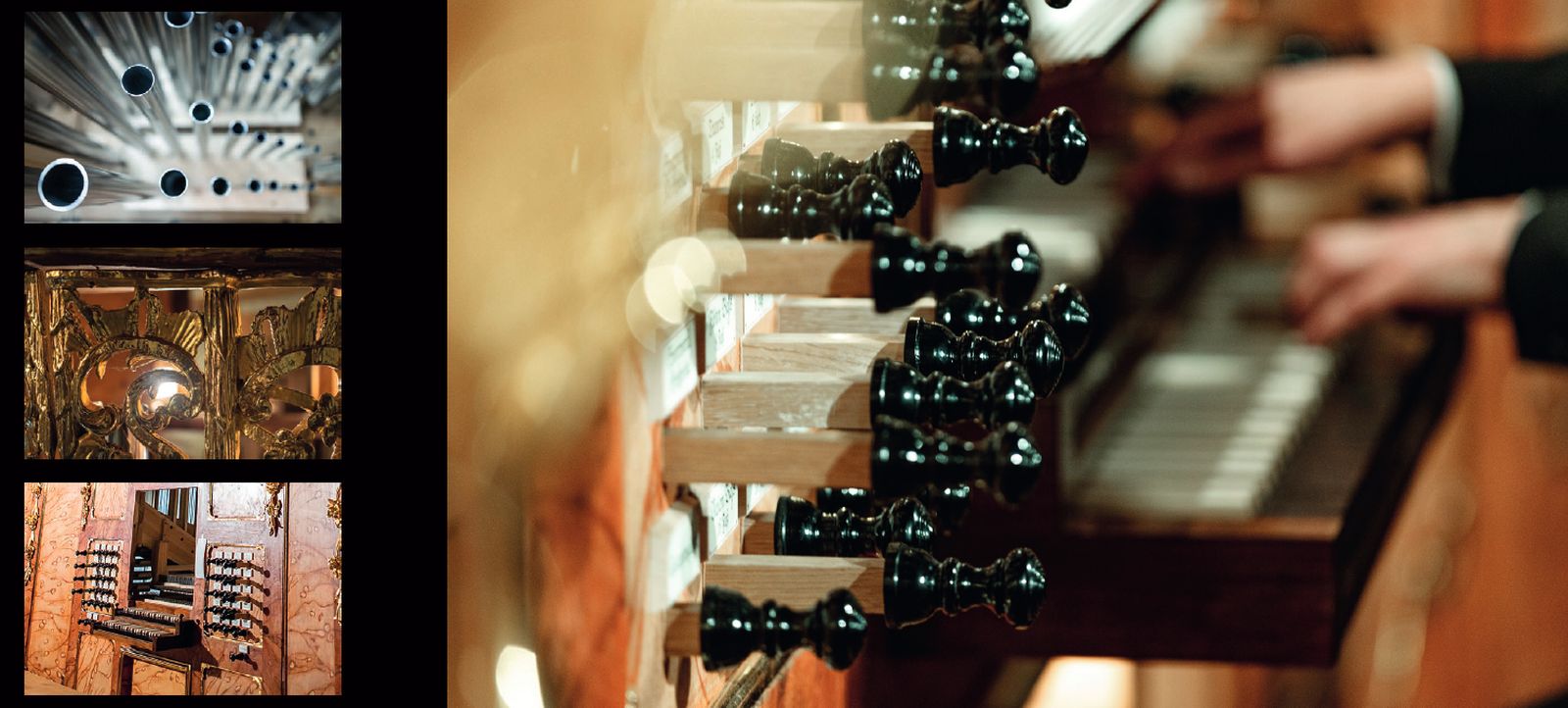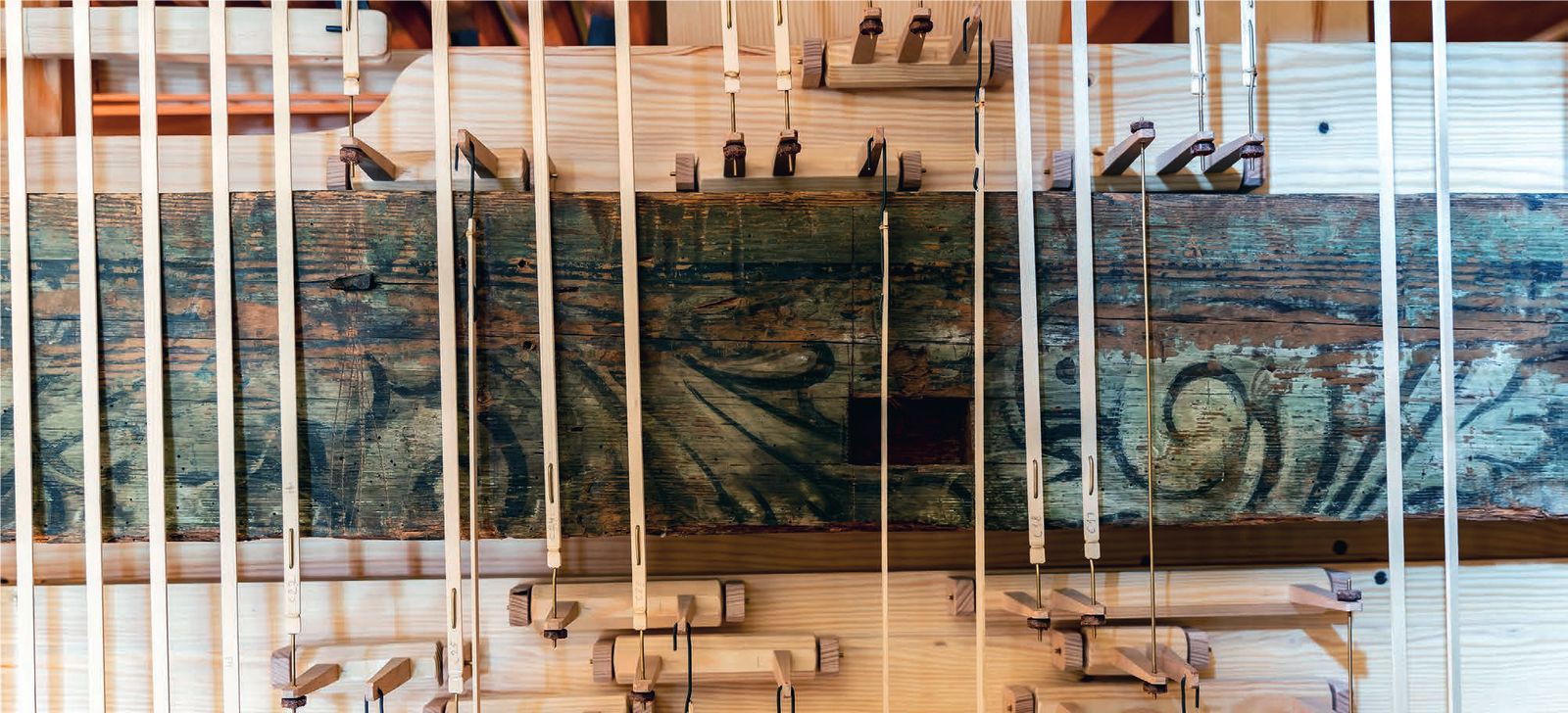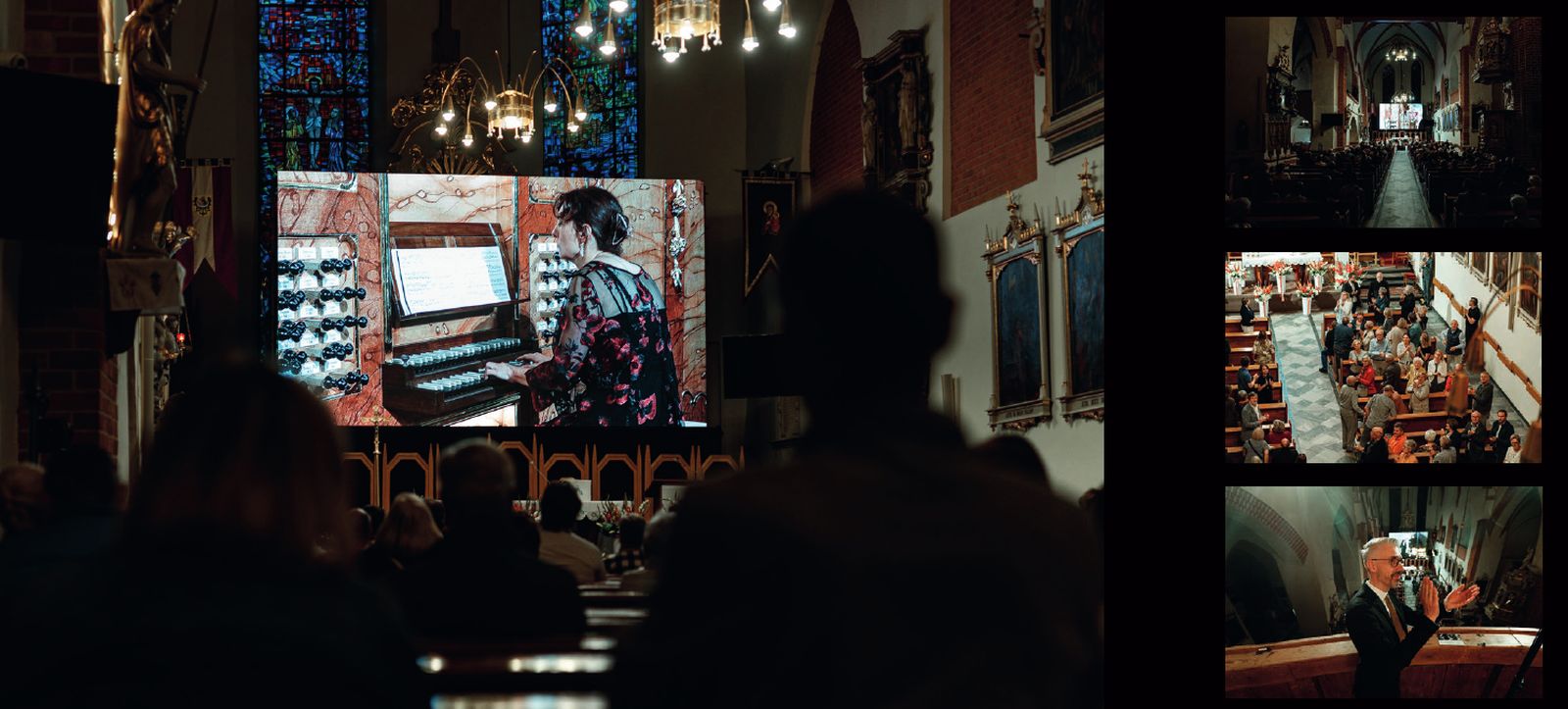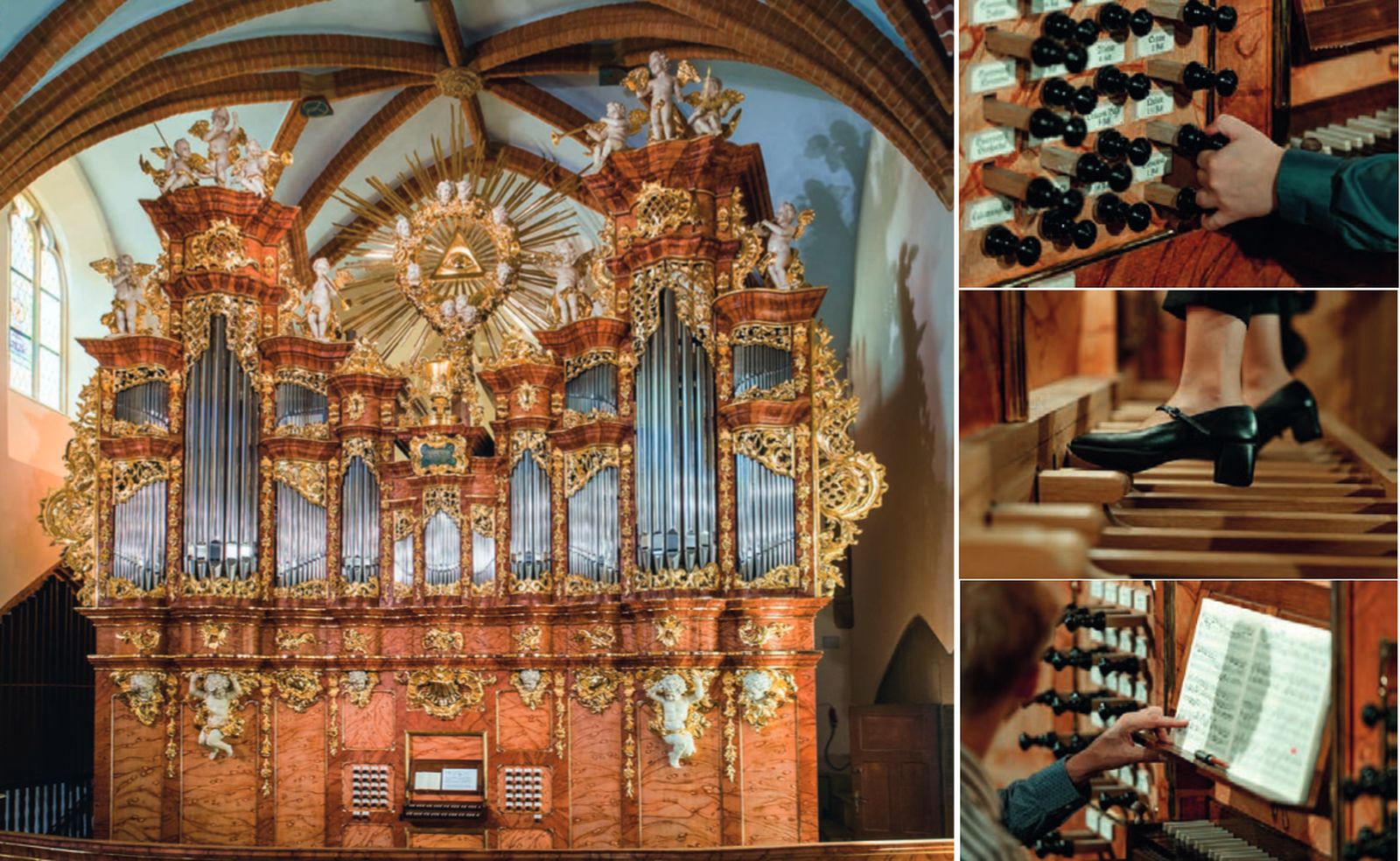ORGAN
Martin Benjamin Liebeherr’s pipe organ at the Church of Our Lady of Czestochowa in Lubin
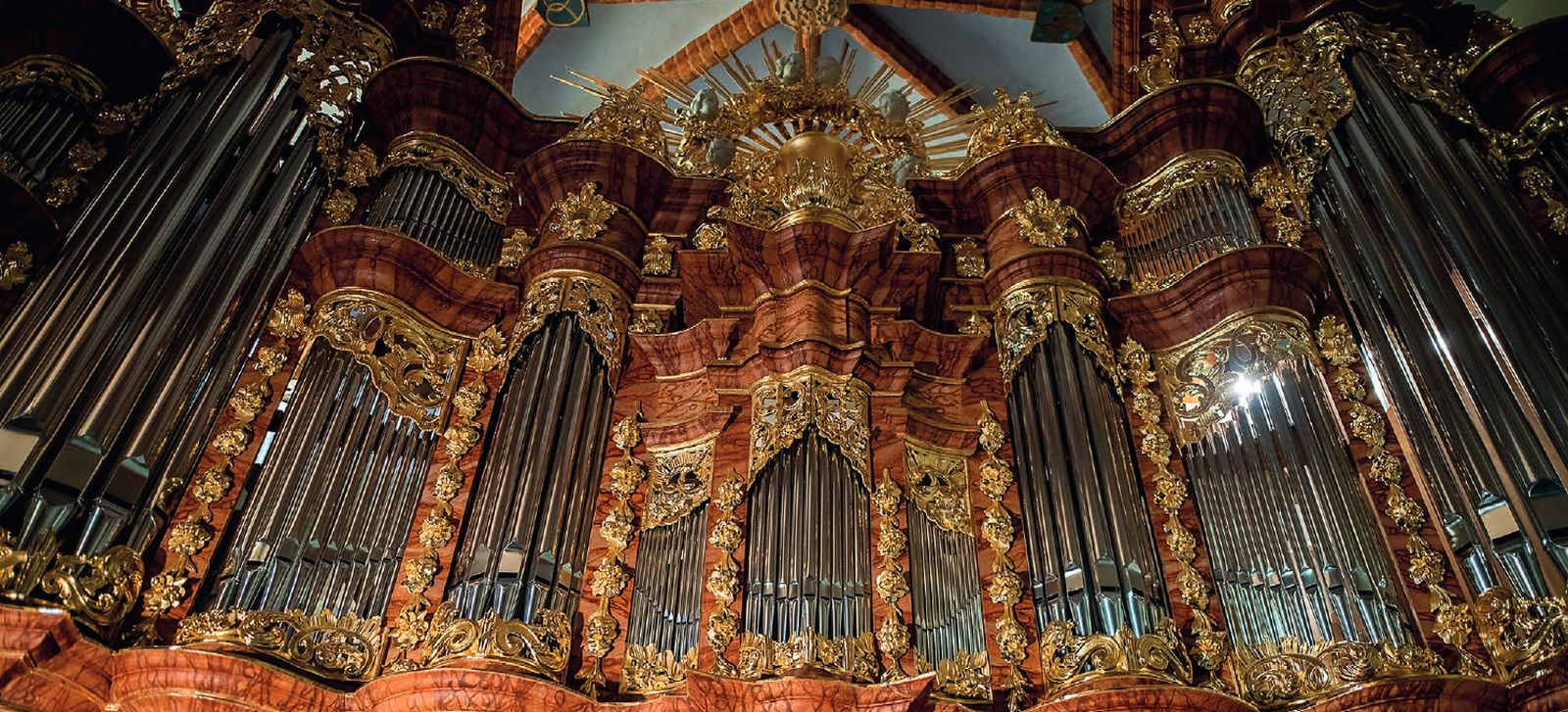
Inauguration
The inauguration of the reconstructed pipe organ took place on 31 August 2022. The date was not accidental. This is the 40th anniversary of the Lubin Massacre, one of the most brutal and bloody pacifications of citizens in the history of the People’s Republic of Poland. The solemn Holy Mass with the consecration of the organ was conducted by Bishop Ignacy Deca. The Mass was said with liturgical accompaniment by Tomasz Głuchowski, a vocal octet under the direction of Alan Urbanek and the chamber ensemble of the Polish National Wind Orchestra in Lubin. The Mass was attended among others by the President of Poland Andrzej Duda, the Mayor of Lubin Robert Raczynski, the Prime Minister of Poland Mateusz Morawiecki and the Marshal of the Sejm Elżbieta Witek.
The Mass was followed by a concert for the inauguration of the pipe organ performed by Ludger Lohmann – (Germany). The programme included compositions by, among others: J.S. Bach, W.A. Mozart, F. Liszt.
The inauguration of the pipe organ marked the start of a cultural event called Lubin Culture 2022, which took place from 31.09-3.09.2022 and included three organ recitals by prominent artists – Ludger Lohmann, who performed the first inaugural recital, Hanna Dys and Holger Gehring. The Lubin Culture 2022 event also included a masterclass for students led by Ludger Lohmann, an organ marathon, numerous workshops (including calligraphy and goldsmithing techniques), and other attractions for the city’s residents. During the event, there was no shortage of music-thirsty audiences enthralled by the sound of the new magnificent organ built by Orgelbau Klais under the supervision of Mr Andrzej Lech Kriese. The concerts were conducted by the invaluable Piotr Matwiejczuk. The musical director of the event was Ms Hanna Dys.
Hanna Dys
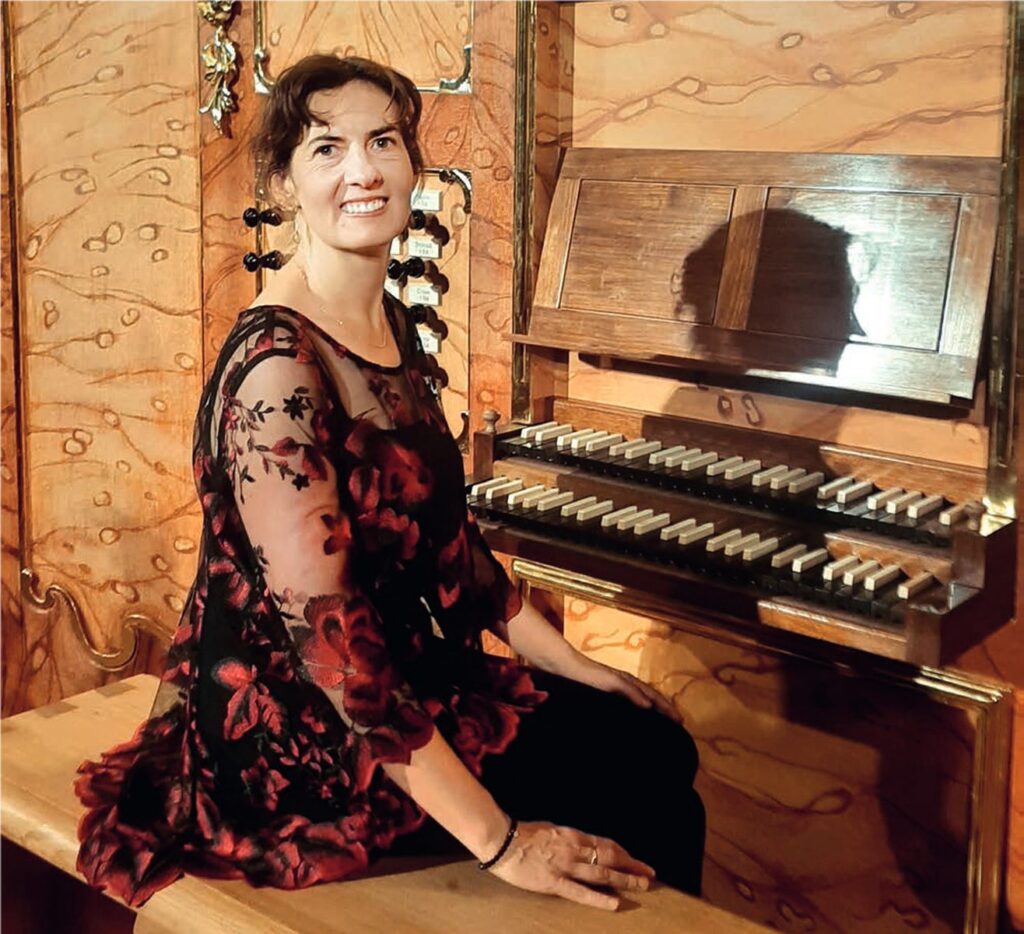 Organist, teacher, works as a professor at the Academy of Music in Gdansk, organizer of cultural activities, originator and director of the Organ and Chamber Music Festival in Grudziadz, artistic director of the Lubin Culture 2022.
Organist, teacher, works as a professor at the Academy of Music in Gdansk, organizer of cultural activities, originator and director of the Organ and Chamber Music Festival in Grudziadz, artistic director of the Lubin Culture 2022.
Graduate of the Academy of Music in Gdańsk (class of Prof. Roman Perucki) and in Hamburg (class of Prof. Wolfgang Zerer, honours degree). Scholarship holder of, among others, Brahms Stifftung, Scholarship for Creators of Culture and Scholarship of the Minister of Science and Higher Education. Laureate and participant of international competitions.
Hanna Dys has performed solo recitals and chamber concerts at the most important organ music festivals in Poland and abroad (including Italy, Finland, Russia, Norway, Germany, Moldova, Spain). Her concert performances promote Polish organ music and among other things she chose to record a monographic album with works by Mieczysław Surzyński for her habilitation. She participated in the recording project of all organ symphonies by Feliks Nowowiejski and compositions by Daniel Magnus Gronau, a composer from Gdańsk. She teaches at the General School of Music in Gdańsk Her pupils and students are prize winners in organ competitions. She regularly provides master classes in Poland and abroad, e.g. in Russia, Lithuania and Italy. She is a juror of organ competitions, as well as a consultant of the Centre for Artistic Education. She presents the organs of the Oliwa Cathedral. Her recordings include both, solo and chamber music repertoire, including those nominated for the Fryderyk music awards. Winner of the prestigious Muzyczne Orły 2020 competition.
CD
Dear Sirs,
The pipe organ sounded anew on 31 August 2022. The date is not accidental. This is the 40th anniversary of the Lubin Massacre, one of the most brutal and bloody pacifications of citizens in the history of the People’s Republic of Poland. In those difficult times, faith was the strength that allowed us to survive. It is my wish that organ concerts will always be the highlight of celebrations dedicated to the heroic inhabitants of Lubin who demonstrated their love for freedom and faith during martial law. It is one of Lubin’s most important monuments. Once again resounding for you and for the glory of the Lord. A CD has also been released, which is a real illustrative and sonic journey.

Mayor of the City of Lubin
Robert Raczynski

The repertoire of this CD consists of some of the musical works performed during the recital on 1 September by artistic director of the Lubin Culture 2022, Hanna Dys.
Disposition of the organ
Manual I /Hauptwerk/ – 13’
Bordun Flaute 16’
Principal 8’
Salicet 8’
Gemshorn 8’
Flaute 8’
Octave 4’
Traverse 4’
Flaute 4’
Quinte 3’
Octave 2’
Mixtur VI 2’
Scharf III 2/3’
Trombet 8’
Manuał II /Positiv/ – 10’
Flaute 8’
Fugara 8’
Principal 4’
Gemshorn 4’
Octave 2’
Quinte 1 1/2’
Sedecima 1’
Sesquialtera II 3’
Mixtur III 1’
Pedal – 7’
Principalbass 16’
Violonbass 16’
Subbass 16’
Octavbass 8’
Flautbass 8’
Octavbass 4’
Posaune 16’
How did it start…?
The history of the pipe organ in the Church of Our Lady of Czestochowa in Lubin is much longer than is suggested by the preserved elements in the renovated instrument, which come from the 2nd half of the 18th century. According to the first information confirmed in historical sources, already in 1595 the church had an organ with a renaissance prospect, located in the western gallery. Unfortunately, there are no details about the disposition, the time of construction or the name of the builder. However, it is known that the organ was renovated and rebuilt in 1619. It was reported in 1654 that the church had two instruments – the second was in the north gallery.
In the second half of the 18th century, it became necessary to build a new instrument for the Lubin Church. This task was entrusted in 1783 to Martin Benjamin Liebeherr, an organ-builder from Góra Śląska, having regard to his work on a new instrument in his home town and the work he had done on an instrument in the contemporary Church of Saint Apostles Peter and Paul in Legnica (today’s Cathedral). Liebeherr, having previously extended the organ gallery, built a magnificent instrument which he put into service in 1785.
Martin Benjamin Liebeherr’s organ was deeply embedded in the traditions of Silesian organ building. It had 27 notes distributed over two manuals with C-c3 range and a pedalboard with C-c1 range, a mechanical key and stop action, slider and pallet wind chests, four wedge bellows for air supply, and a built-in console. Although the size of the instrument can be described as medium (in accordance with the realities of that time), considerable tonal variety was provided within the individual sections, yet forming a certain coherent whole.
The appearance of the organ casing itself, and especially its frontal portion – the organ façade – also played an important role. Unfortunately, we do not know the name of its creator. The façade itself was designed in the form of wings, arches, making full use of the space of the organ gallery, and was a model example of the Silesian type of building. It was symmetrical, with side pipe towers higher than its central section, above which was the Gloria surrounded by a cherubic orchestra. It also contained rich carvings and other decorations, such as music playing cherubs, ornamental curtains in the pipe organ area, frame extensions, festoons, bunches, which filled individual parts of the organ façade.
The instrument survived in this form until 1865, when it was rebuilt in the face of changes in the field of organ building and the preferred type of sound. The company Gebruder Walter from Góra Śląska finished the work in 1866. The existing organ was partly dismantled, new wind chests were made, the keyboard range was extended by two additional keys, the tracker action was replaced and some ranks of pipes were changed, adding one additional note. It is known that the aforementioned company also maintained the instrument until 1890.
Another important date in the history of the Lubin organ is the year 1905, when another major reconstruction of the instrument took place. The disposition was changed again, most of the monumental pipes were replaced with new ones, the tracker action was changed to a pneumatic one, a blower was installed for a new bellow, wind chest was replaced and a free-standing console was made. The work was probably carried out by the company Schlag und Sőhne from Świdnica.
During the First World War (1914-1918), the façade pipes, which were made of good quality tin, were requisitioned for military purposes. The deficiencies were not completed until 1924. However, at the end of the Second World War (1939-1945), the Church was heavily damaged as a result of military action and was slowly devastated over the two years following the end of the war. From 1947 to 1951, the Church was in the possession of the Orthodox parish, while its transfer to the Catholic parish took place in 1959.
Unfortunately, the instrument’s post-war history was a slow process of decline due to difficulties in acquiring good materials, specialists or a lack of decision on the instrument’s form itself. In 1958, the organ was dismantled and loaded onto a railway carriage for removal, which, however, did not take place thanks to the intervention of the railwaymen. After this incident, the organ returned to the Church and was extensively renovated between 1961 and 1962. Minor works were carried out thereafter (in 1970 and 1978). The latter concerned changes to the ranks of pipes to make it compatible with the already existing new console.
The next major reconstruction was carried out by the organ-builder Antoni Szydłowski’s company from Wrocław in the years 1997-1998. This involved the replacement of wind chests, key and stop action elements, bellows, plates with note names in the console. By then, the instrument already had 35 notes divided into three manuals ranging C-a3 (although actually up to f3) and a pedalboard ranging C-f1 (actually up to d1).
The progressive exploitation of the instrument, combined with materials of insufficient quality that were used in the post-war renovations of this instrument, led to the idea of restoring it. The talks were initiated by the Mayor of Lubin, Robert Raczyński, and were also attended by the late Marek Garcarz, a social activist and musician, and Andrzej Lech Kriese, an organ builder. Various concepts emerged – from constructing a completely new instrument, through partial construction to complete revitalisation and historical reconstruction. In the end, it was decided to build a new organ in the style of Martin Benjamin Liebeherr, making use of the historical elements of his instrument that have survived to the present day.
The contract was signed in 2020 between the Commune of Lubin and a consortium of companies: Johannes Klais Orgelbau GmbH & Co.KG and Zych Organ Works Dariusz Zych under the supervision of the city’s expert organ builder, Andrzej Lech Kriese. The reconstruction work took two years, until August 2022. The use of all available archival sources, analogies from the time when the original instrument was built, high-quality materials and the artistry of craftsmen and artists, resulted in the creation of an instrument that is unique both regionally and nationally.
The instrument itself currently has a slightly larger than original set of pipes, comprising 30 notes, which is split into two manuals with C-d3 range and one pedalboard with C-d1 range. The extension of the instrument’s range and sound potential resulted from the need to perform contemporary compositions, which allows for broader use of the instrument in the spirit of the era to which it refers. All components of the organ – from the tracker action, through the wind system, to the ranks of pipes – were built in accordance with the 18th century organ-building traditions, bringing the instrument as close as possible to the original put into service by Liebeherr in 1785.
The restored organ casing, the preserved ornaments and the added wood-carving decorations additionally increase the visual qualities of the instrument itself, which, in correlation with its unique and sublime sound, intensify the aesthetic sensations of listeners and performers, as well as increase the values of the interior decoration of the church in which the organ has been placed.
There are a total of 1,872 pipes in the instrument, 315 of which are made of wood, while the rest are made of various tin-lead alloys. The smallest pipe is only 11 mm long, while the largest is 4.8 m long. The frequencies of the sounds they produce range from 32 to about 15600 Hz, which is almost the entire spectrum of sounds picked up by the human ear. A total of about 25 cubes ( i.e. 1 m3) of twelve types of wood were used – mainly pine, spruce and oak, but also ebony, rosewood or French walnut. The metal pipes were made from an alloy of tin and lead in various proportions. The more tin in the alloy, the brighter the colour and sounding of the pipe, it is glossy and harder. These can be found in the façade, as they are the most representative of all ranks of pipes. In the façade, the tin content of the alloy is about 80% – the rest consists of lead, chromium, molybdenum and a negligible addition of copper (about 0.02%). The less tin in the pipe alloy, the more lead, the darker the colour and sound of the pipes, they are heavier, matt and more plastic. They are placed inside the instrument. Their tin content is about 28%, but lead is already 70% of the alloy. The other metals are chromium, cadmium, molybdenum and trace admixtures of other elements that stabilise the whole alloy. The total length of the whole tracker action, which consists of wooden couplers and trackers, reaches almost half a kilometre. The carvings and other decorations are made up of almost 300 elements, which were plated with 24-carat gold using the traditional method. Almost half a kilogram of pure gold, prepared as flakes 0.013 mm thick, which is less than the thickness of a human hair, was used for this purpose. The entire instrument weighs about 18 tonnes, filling almost the entire area of the organ gallery. A total of 60 people from two countries worked on the creation of this pipe organ over a period of two years.
© 2024 The Polish National Wind Orchestra in Lubin. All rights reserved
